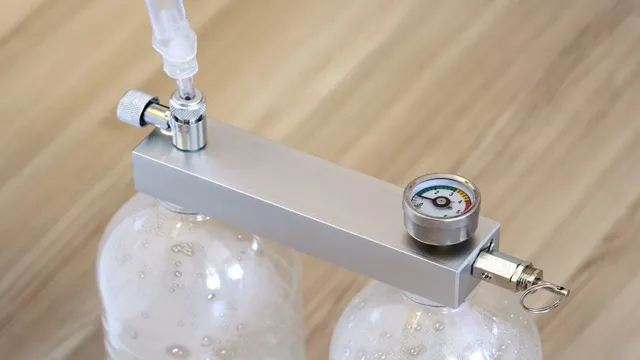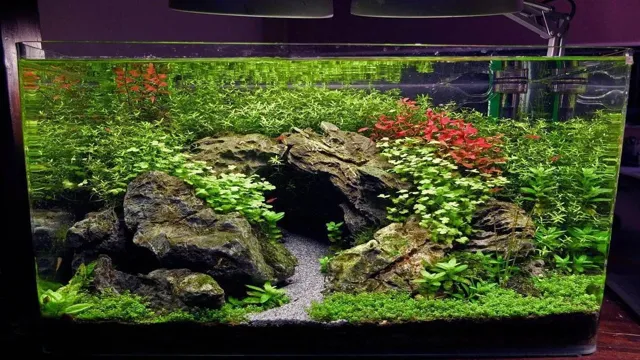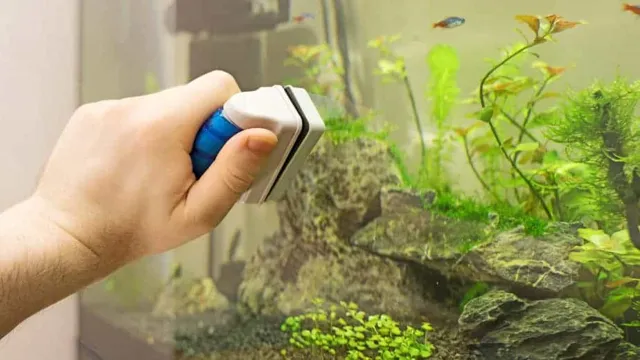Have you been struggling to maintain a healthy and thriving aquarium? One solution you might consider is adding CO2 to your tank. Many aquarium enthusiasts use CO2 injection as a way to prime their plants for photosynthesis and ensure their fish are healthy and happy. But how exactly does CO2 benefit your aquarium? First, CO2 helps plants to grow more efficiently by increasing their carbon intake.
When plants have enough CO2, they can carry out photosynthesis and produce more oxygen for the fish in your tank. Additionally, introducing CO2 can help balance the pH levels in your tank, creating a more stable environment for your aquatic pets. While adding CO2 to your aquarium may seem daunting at first, it’s actually a simple process.
All you need is a CO2 tank, a regulator, and a diffuser to disperse the gas into the water. It’s important to carefully regulate the amount of CO2 you add to your tank, however, as too much can harm your fish. If you’re looking to give your aquarium a boost, consider adding CO2 to your maintenance routine.
Not only will your plants and fish benefit, but you’ll also create a more enjoyable and beautiful aquarium experience.
Why Add CO2?
If you want to maintain a lush and healthy aquarium, introducing CO2 can be crucial. Carbon dioxide is an important nutrient for aquatic plants, and it can dramatically increase their growth rate, helping to create a stunning underwater environment. One option for introducing CO2 into your aquarium is through a CO2 injection system.
These systems use a pressurized cylinder or container to diffuse CO2 into the water through a diffuser or atomizer. This method can be effective but may require some trial and error to find the right amount of CO2 for your particular tank. Another option is to use CO2 tablets, which dissolve in the water and release CO2 over time.
This method can be more convenient and doesn’t require the purchase of expensive equipment. Ultimately, introducing CO2 to your aquarium can help you achieve a gorgeous and thriving aquatic ecosystem.
Benefits of CO2 in Aquariums
CO2 If you have an aquarium and you want your aquatic plants and fish to thrive, adding CO2 can be an excellent choice. CO2, or carbon dioxide, is an essential element that aquarium plants need to grow. When adding CO2 to your aquarium, plants can absorb carbon dioxide more efficiently through photosynthesis, which allows them to grow and produce more oxygen.
With the addition of CO2, you’ll notice that your aquarium plants are healthier and more vibrant, creating a visually stunning underwater ecosystem that your fish will love. Additionally, adding CO2 can help regulate pH levels in your aquarium, making it easier to maintain a stable and healthy environment for your aquatic pets. Overall, adding CO2 to your aquarium can be a simple, yet effective way to help your plants and fish thrive and create a beautiful underwater world.

Methods of Adding CO2
If you’re looking to enhance your aquarium plant growth, adding CO2 is one of the best things you can do. The trick is figuring out how to introduce CO2 into your aquarium. One of the easiest ways is to use a CO2 diffuser, which distributes the CO2 evenly throughout the tank.
Another option is to use a CO2 injector, which releases CO2 directly into the water through a tube. Some aquarium owners prefer setting up a DIY CO2 system, using a combination of yeast, sugar, and water to create CO2 gas. This method is cost-effective but requires more maintenance than the other options.
It’s essential to keep in mind that adding too much CO2 can have harmful effects on the fish and plants in your aquarium. Start with a low dosage and gradually increase it as necessary. With proper CO2 management, your aquarium plants will thrive, providing a beautiful and healthy environment for your fish.
Pressurized CO2 Systems
One method of adding CO2 to a pressurized system is through a diffuser. A diffuser atomizes the CO2, creating tiny bubbles that dissolve more easily into the water. This results in more efficient absorption of CO2 by aquatic plants.
Another method is injecting CO2 directly into the water. This method is typically used in larger aquariums or aquascapes where diffusers may not be effective enough. Lastly, it’s possible to use a pH controller, which measures the pH level of the water and adds CO2 as needed to maintain a consistent level.
A pH controller is a useful tool for those who want to automate their CO2 system and avoid the daily task of manually testing and adjusting the pH level. Whichever method you choose, it’s essential to maintain healthy CO2 levels in your aquatic environment. A well-balanced CO2 system will promote healthy plant growth, which, in turn, supports the overall health of your aquatic ecosystem.
DIY CO2 Methods
DIY CO2 Methods CO2 is vital for healthy plant growth, but adding CO2 to your aquarium can be expensive. Thankfully, there are a number of DIY CO2 methods that are both cost-effective and easy to implement. One such method is the yeast-based CO2 generator.
As the name implies, this method involves using yeast to generate CO Simply mix some yeast, sugar, and warm water in a bottle, and attach a tube to the top. This tube can then be used to introduce the CO2 into your aquarium. (See Also: How to Add Fish to Your Aquarium in Fishing Simulator: A Step-by-Step Guide)
Another method involves using citric acid and baking soda. This method is more complex than the yeast method, but it can be more powerful in terms of CO2 production. Be sure to research the different DIY CO2 methods to find the right one for your aquarium.
With a little trial and error, you can find the perfect solution for your needs.
How to Choose the Right Method for Your Aquarium
If you’re an aquarium enthusiast looking to add CO2 to your tank, there are several methods to consider. One of the most popular ways to introduce CO2 is through a pressurized system, which involves using a canister to hold and release CO2 into the water. Another option is a DIY yeast CO2 system, which is less expensive but requires more maintenance and may not be ideal for larger tanks.
It’s important to keep in mind the needs of your specific fish and plants when choosing the right method, as some may require higher levels of CO2 than others. It’s also important to monitor CO2 levels regularly to ensure they remain within safe levels for your aquatic inhabitants. Overall, the key is to choose a method that fits your budget, maintenance preferences, and tank size, while also prioritizing the health and well-being of your aquarium’s inhabitants.
So, whether you decide to go the pressurized route or opt for a DIY system, introducing CO2 to your aquarium can be a rewarding and beneficial choice for both your plants and fish.
Considerations for Beginner and Advanced Aquarists
Choosing the right method for your aquarium can be a daunting task, especially for beginners. However, there are a few key considerations that can help both beginner and advanced aquarists make the right decision. Firstly, it’s important to consider the type of fish you have or plan to have in your tank.
Some fish require specific water conditions and filtration methods, so it’s important to research and choose a method that can accommodate their needs. Another factor to consider is the size of your aquarium. Larger tanks may require more advanced filtration methods to ensure the water is clean and healthy for your fish.
Additionally, it’s important to consider the level of maintenance required for each method, as some may require more upkeep than others. By taking these factors into account, you can make an informed decision and choose a method that will suit both the needs of your fish and your personal preferences.
Step-by-Step Guide to Adding CO2 to Your Aquarium
Adding CO2 to your aquarium can be a daunting prospect, but it doesn’t have to be. With a few simple steps, you can introduce CO2 into your aquarium and watch your plants thrive. First, you’ll need a CO2 system, which typically consists of a cylinder, regulator, and diffuser.
Once you’ve assembled your system, you’ll need to position your diffuser in your aquarium. This should be placed close to your plants, ideally in a location where there is good water flow. You’ll then need to adjust the flow rate to ensure that the CO2 is being distributed evenly throughout the aquarium.
Once your system is up and running, it’s important to monitor your pH levels as too much CO2 can bring your pH levels down to dangerous levels for your fish. Regular maintenance is also essential, including cleaning and refilling your cylinder when necessary. With a little care and attention, introducing CO2 to your aquarium can be a simple way to enhance the health and beauty of your aquatic plants.
Setting Up Your CO2 System
Setting up your CO2 system for your aquarium can be a bit daunting, but with the right steps and tools, you can have your plants thriving in no time. The first step is to choose the right CO2 equipment based on the size of your aquarium. You’ll need a regulator, CO2 cylinder, tubing, and diffuser.
Once you have your equipment, it’s time to set it up. Connect the regulator to the CO2 cylinder and then attach the tubing to the regulator. The tubing should be long enough to reach the bottom of your aquarium.
Lastly, attach the diffuser to the tubing and place it in your aquarium. The diffuser will release the CO2 bubbles into the water, providing the plants with the necessary carbon they need for photosynthesis. It’s important to monitor the CO2 levels using a drop checker and adjust the flow rate as needed.
With patience and proper maintenance, your aquarium plants will be healthy and vibrant.
Regulating CO2 Levels
Regulating CO2 levels in your aquarium is crucial for ensuring healthy plant growth and maintaining a balanced ecosystem. Adding CO2 to your aquarium can be intimidating, but with this step-by-step guide, it’s easy to do. The first thing to consider is how much CO2 your plants need. (See Also: How to Protect Carpet from Aquarium: Tips and Tricks for Keeping Carpets Clean and Safe)
You can determine this by researching the specific needs of the plants in your aquarium. Next, decide on the method of CO2 delivery – there are several options, including diffusion through a CO2 reactor or using a CO2 injection system. Once you’ve chosen your method, set up and calibrate the CO2 system according to the manufacturer’s instructions.
It’s important not to overdo it with CO2, as high levels can be harmful to fish. Monitor the CO2 levels regularly and adjust as needed. With a little bit of research and attention, adding CO2 to your aquarium can be a simple and effective way to promote healthy plant growth and keep your aquatic ecosystem thriving.
Monitoring CO2 Levels
If you want to have healthy and thriving aquatic life in your aquarium, it’s important to monitor the CO2 levels. Adding CO2 to your aquarium is a great way to promote healthy plant growth, but it’s important to do it right. Here’s a step-by-step guide to adding CO2 to your aquarium:
Install a CO2 injection system: Before adding CO2, you need to install a reliable CO2 injection system. There are different types of systems available, but the most common one is the pressurized system. It’s easy to install, and it’s efficient in delivering CO2 to your aquarium.
Test your CO2 levels: Once you’ve installed the CO2 system, you need to monitor the CO2 levels regularly. Use a CO2 drop checker kit to get an accurate reading of the CO2 levels in your aquarium.
It’s important to keep the CO2 levels within the optimal range to avoid stressing your fish. Adjust the CO2 levels: If you find that the CO2 levels are too low, you need to adjust the injection rate.
Start by increasing the injection rate slowly and monitor the levels to avoid sudden changes that could shock your fish. If the CO2 levels are too high, reduce the injection rate.
Monitor the pH levels: When you add CO2 to your aquarium, it can lower the pH levels. It’s important to monitor the pH levels regularly and adjust the CO2 injection rate accordingly. Adding CO2 to your aquarium can help promote healthy plant growth, and it’s not as complicated as you may think.
Troubleshooting Common CO2 Issues
Introducing CO2 into an aquarium can be a bit of a challenge, and it’s not uncommon to run into a few issues. One of the most common problems is insufficient CO2 levels, which can be seen in plants that aren’t growing as well as they should be. To fix this issue, first make sure that your CO2 system is set up and working properly.
Check that your CO2 tank is full and that your regulator is set to the proper flow rate. If everything looks good here, consider increasing the diffusion rate of your CO2 into the tank by adjusting the positioning of the diffuser. Another common issue that aquarists encounter is fluctuating CO2 levels.
This can be caused by changes in the water’s temperature or pH, or by a malfunctioning CO2 system. To fix this, try to stabilize the water’s parameters and ensure that your CO2 system is functioning correctly. Additionally, be sure to monitor your CO2 levels regularly to catch any issues before they become severe.
Algae Overgrowth
Algae overgrowth can be a common problem for aquarium owners, and it’s often caused by CO2 issues. When there’s not enough CO2 in the water, algae can take over and thrive, creating an unsightly and potentially harmful environment for your fish. One way to troubleshoot this issue is to test your water parameters and ensure that your CO2 levels are within the appropriate range for your plants and fish.
Adding a CO2 system or increasing the flow of oxygen in the water can also help combat algae overgrowth. It’s important to note that while algae may seem like a small nuisance, it can quickly spiral out of control and harm the delicate balance of your aquarium ecosystem. By taking proactive steps to address algae overgrowth, you can ensure that your fish and plants thrive in a healthy and beautiful environment.
Fish Stress or Death
When it comes to maintaining a healthy aquarium, fish stress or death should be avoided at all costs. One common issue that can lead to stress and even death among fish is an excessive amount of CO2 in the water. This is known as a CO2 overdose.
Signs of a CO2 overdose include fish gasping for air at the surface of the water, lethargy, and even death. To troubleshoot this issue, it’s important to first check the CO2 levels in the tank. If they are too high, it may be necessary to adjust the CO2 diffuser or reduce the amount of CO2 being added to the water.
Another common issue is poor circulation, which can cause CO2 to build up in certain areas of the tank. To prevent this, consider installing a powerhead or additional filter to improve water flow. By closely monitoring CO2 levels and taking steps to improve circulation, you can help ensure that your fish remain healthy and happy in their aquatic home. (See Also: How to Kill Aquarium Fish: Top Strategies and Tips to Prevent Inhumane Practices)
Equipment Malfunction
CO Equipment malfunction is a common issue that can cause a headache for many CO2 users. Fortunately, most problems can be resolved by troubleshooting common CO2 issues.
One of the most common issues that arise is low or fluctuating CO2 pressure. This problem could arise from a leak in the system, a regulator malfunction, or simply running out of CO To fix the issue, first, check for leaks in the system and tighten any loose connections.
If the regulator is the issue, adjust it accordingly. Another issue that could arise is clogging due to the buildup of sediment or debris in the CO2 tank or lines. This can cause an uneven flow of CO2 or blockage in the system.
To fix the issue, clean out the tank and lines before restarting the system. By regularly checking and troubleshooting common CO2 issues, you can ensure that your system runs smoothly and efficiently.
Conclusion and Final Thoughts
In conclusion, introducing CO2 into an aquarium is a delicate balance between science and art. It requires patience, precision, and a willingness to experiment. Like a symphony conductor, the aquarist must harmonize the elements in the tank to create a beautiful and sustainable ecosystem.
So, whether you’re a seasoned pro or a newbie in the world of aquariums, remember to approach the process with open-mindedness and a willingness to learn. And who knows, you just might discover that your aquarium has the potential to be the next great masterpiece.”
FAQs
Why is it important to introduce CO2 into an aquarium?
CO2 is essential for aquatic plants to undergo photosynthesis and produce oxygen, which is necessary for the health of fish and other organisms in the tank.
What are some methods for introducing CO2 into an aquarium?
Some methods include using a CO2 injection system, adding CO2 via a diffuser, or using a CO2 gas reactor.
How much CO2 should be added to an aquarium?
The ideal concentration of CO2 in an aquarium is typically between 20-30 ppm (parts per million), though this may vary depending on the specific needs of the plants and animals in the tank.
What are the benefits of using a CO2 injection system?
Using a CO2 injection system can help increase the growth and vitality of aquatic plants, improve the overall health and appearance of the aquarium, and reduce algae growth.
How often should CO2 be added to an aquarium?
CO2 should typically be added to an aquarium on a regular basis, with some systems requiring daily additions and others only needing weekly or monthly dosing.
What are some potential risks of adding too much CO2 to an aquarium?
Adding too much CO2 to an aquarium can cause harm to fish and other organisms living in the tank, and can also lead to excessively high pH levels or other imbalances that can negatively affect the ecosystem.
How can I monitor the CO2 levels in my aquarium?
There are a variety of tools available for measuring CO2 levels in an aquarium, including pH monitors, CO2 drop checkers, and electronic monitors. It’s important to regularly check these levels to ensure that the aquarium is healthy and balanced.







